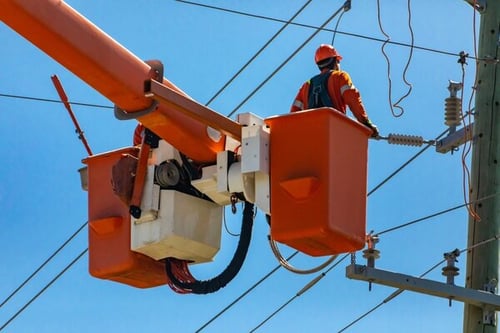As with most critical applications, the correct choice of hydraulic hose for heavy lifting is vitally important. Whether it’s for system design or preventative maintenance, one must consider the temperature ranges, pressure ratings, bend diameter, and cover material. Use support brackets where applicable to avoid unnecessary flexing and ensure the best hose position and avoid a bend that is tighter than the minimum radius allowed. And use thermoplastic hoses for lightweight options, tighter than normal bend radiuses and wherever electricity may be present because a hydraulic hose with steel braids in it will have the high potential of conducting electricity.
Hydraulic Hose for Heavy Lifting
Common heavy lifting applications include hydraulic aerial-lift platforms, mobile-lift equipment such as “cherry pickers,” plus construction and agricultural machinery. In many of these applications thermoplastic non-conductive hydraulic hoses are recommended, especially for use in mobile equipment for electrical utilities. Thermoplastic hydraulic hose has an electrically insulating effect, especially when the reinforcement is also thermoplastic, such as polyester, nylon or polytetrafluoroethylene (PTFE). Thermoplastic hose for these applications falls under SAE 100R7 and 100R8 as non-conductive hose for fluid conveyance where there is the potential to transmit or spark electricity. The primary difference of the two specifications is:
pickers,” plus construction and agricultural machinery. In many of these applications thermoplastic non-conductive hydraulic hoses are recommended, especially for use in mobile equipment for electrical utilities. Thermoplastic hydraulic hose has an electrically insulating effect, especially when the reinforcement is also thermoplastic, such as polyester, nylon or polytetrafluoroethylene (PTFE). Thermoplastic hose for these applications falls under SAE 100R7 and 100R8 as non-conductive hose for fluid conveyance where there is the potential to transmit or spark electricity. The primary difference of the two specifications is:
- SAE 100R8 hose spec is a high pressure thermoplastic hydraulic hose for petroleum, water based and synthetic fluids operating at temperatures from -40°F to 212°F (-40°C to 100°C).
- SAE 100R7 hose spec is a medium pressure thermoplastic hose for continuous service for petroleum and synthetic oils operating at temperatures from -65°F to 200°F (-54°C to 93°C).
Other applications for nonconductive hoses are found in rescue tools, foundries, steel mills, shipyards, and mines. Particularly underground mines where fire safety is paramount. In addition, thermoplastic hydraulic hoses provide excellent flexibility, having as much as half the bend radius of a comparable steel-wire reinforced 100R2 hose.
Rubber Versus Bonded Thermoplastic Hydraulic Hose
Historically most hydraulic hoses were made from rubber. However, thermoplastic hose has many advantages over rubber, such as:
- Rubber can weaken from fatigue of the constant flexing motion in many applications. Where the fiber reinforcement that bonds between the hose and jacket of thermoplastic hose can withstand continuous flexing, even at higher pressures.
- Rubber hose will usually become brittle and crack at low temperatures where thermoplastics are the ideal choice for these applications.
Furthermore, thermoplastic hydraulic hose can be easily shaped for routing or bonding for creating a single section from several hoses and has a comparatively high corrosion and chemical resistance.
Using one bonded hose section instead of multiple hoses saves money with reduced installation time, lower material cost, and lower weight of the total assembly. Bonding of two or more hoses into a single assembly eliminates problems from routing multiple hoses individually where they can scrape against each other and likely scuff the covers, leaving the potential for leaks. A bonded hose element also improves the overall strength of the assembly making it highly applicable in aerial lifts, hydraulic cranes, and lift trucks.
Conclusion:
Hydraulic hoses must meet very rigorous standards to perform under changing pressure levels, loads, temperatures and sometimes extreme routing positions. Few engineering components are expected to withstand the forces within and be flexible enough to bend or reach at varying angles to perform heavy-duty functions.
The importance of hydraulic systems cannot be undervalued. Using high pressure hydraulic fluids to produce mechanical output requires fluid transfer lines that will withstand demanding applications such as lifting, forging, or stamping along with backhoes, excavators, wing flaps on airplanes, and other lifting equipment like wheelchair lifts and hydraulic jacks.
Standard rubber industrial hoses are not suitable for use in hydraulic systems. Hydraulic hoses work as vital sections of an enclosed system and must be able to withstand harsh conditions such as high internal pressures, extreme temperatures and lifting applications that must ensure operator and system safety.
Sources Include:

